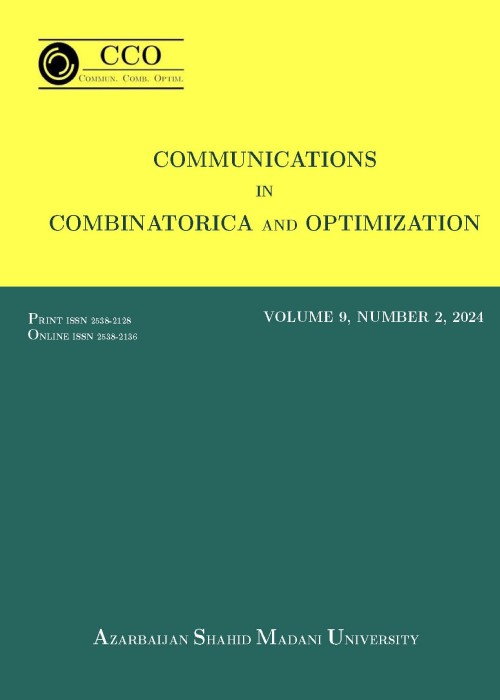فهرست مطالب
Communications in Combinatorics and Optimization
Volume:3 Issue: 1, Winter and Spring 2018
- تاریخ انتشار: 1397/03/01
- تعداد عناوین: 6
-
Pages 1-24A Roman dominating function (RDF) on a graph $G = (V, E)$ is a labeling $f : V rightarrow {0, 1, 2}$ such that every vertex with label $0$ has a neighbor with label $2$. The weight of $f$ is the value $f(V) = Sigma_{vin V} f(v)$ The Roman domination number, $gamma_R(G)$, of $G$ is the minimum weight of an RDF on $G$. An RDF of minimum weight is called a $gamma_R$-function. A graph G is said to be $gamma_R$-excellent if for each vertex $x in V$ there is a $gamma_R$-function $h_x$ on $G$ with $h_x(x) not = 0$. We present a constructive characterization of $gamma_R$-excellent trees using labelings. A graph $G$ is said to be in class $UVR$ if $gamma(G-v) = gamma (G)$ for each $v in V$, where $gamma(G)$ is the domination number of $G$. We show that each tree in $UVR$ is $gamma_R$-excellent.Keywords: Roman domination number, excellent graphs, trees
-
Pages 25-35A {it topological index} of a graph is a real number related to the graph; it does not depend on labeling or pictorial representation of a graph. In this paper, we present the upper bounds for the product version of reciprocal degree distance of the tensor product, join and strong product of two graphs in terms of other graph invariants including the Harary index and Zagreb indices.Keywords: Degree distance, reciprocal degree distance, composite graph
-
Pages 37-50Let $kgeq 1$ be an integer, and let $G$ be a graph. A {it $k$-rainbow dominating function} (or a {it $k$-RDF}) of $G$ is a function $f$ from the vertex set $V(G)$ to the family of all subsets of ${1,2,ldots ,k}$ such that for every $vin V(G)$ with $f(v)=emptyset $, the condition $bigcup_{uin N_{G}(v)}f(u)={1,2,ldots,k}$ is fulfilled, where $N_{G}(v)$ is the open neighborhood of $v$. The {it weight} of a $k$-RDF $f$ of $G$ is the value $omega (f)=sum _{vin V(G)}|f(v)|$. A $k$-rainbow dominating function $f$ in a graph with no isolated vertex is called a {em total $k$-rainbow dominating function} if the subgraph of $G$ induced by the set ${v in V(G) mid f (v) not = {color{blue}emptyset}}$ has no isolated vertices. The {em total $k$-rainbow domination number} of $G$, denoted by $gamma_{trk}(G)$, is the minimum weight of a total $k$-rainbow dominating function on $G$. The total $1$-rainbow domination is the same as the total domination. In this paper we initiate the study of total $k$-rainbow domination number and we investigate its basic properties. In particular, we present some sharp bounds on the total $k$-rainbow domination number and we determine {color{blue}the} total $k$-rainbow domination number of some classes of graphs.Keywords: $k$-rainbow dominating function, $k$-rainbow domination number, total $k$-rainbow dominating function, total $k$-rainbow domination number
-
Pages 51-70An infeasible interior-point algorithm for solving the $P_*$-matrix linear complementarity problem based on a kernel function with trigonometric barrier term is analyzed. Each (main) iteration of the algorithm consists of a feasibility step and several centrality steps, whose feasibility step is induced by a trigonometric kernel function. The complexity result coincides with the best result for infeasible interior-point methods for $P_*$-matrix linear complementarity problem.Keywords: Linear complementarity problem, Full-Newton step, Infeasible interiorpoint method, Kernel function, Polynomial complexity
-
Pages 71-77A double Roman dominating function on a graph $G$ with vertex set $V(G)$ is defined in cite{bhh} as a function $f:V(G)rightarrow{0,1,2,3}$ having the property that if $f(v)=0$, then the vertex $v$ must have at least two neighbors assigned 2 under $f$ or one neighbor $w$ with $f(w)=3$, and if $f(v)=1$, then the vertex $v$ must have at least one neighbor $u$ with $f(u)ge 2$. The weight of a double Roman dominating function $f$ is the sum $sum_{vin V(G)}f(v)$, and the minimum weight of a double Roman dominating function on $G$ is the double Roman domination number $gamma_{dR}(G)$ of $G$. A set ${f_1,f_2,ldots,f_d}$ of distinct double Roman dominating functions on $G$ with the property that $sum_{i=1}^df_i(v)le 3$ for each $vin V(G)$ is called in cite{v} a double Roman dominating family (of functions) on $G$. The maximum number of functions in a double Roman dominating family on $G$ is the double Roman domatic number of $G$. In this note we continue the study the double Roman domination and domatic numbers. In particular, we present a sharp lower bound on $gamma_{dR}(G)$, and we determine the double Roman domination and domatic numbers of some classes of graphs.Keywords: Domination, Double Roman domination number, Double Roman domatic number
-
Pages 79-91Let $G=(V, E)$ be a simple graph with vertex set $V$ and edge set $E$. A {em mixed Roman dominating function} (MRDF) of $G$ is a function $f:Vcup Erightarrow {0,1,2}$ satisfying the condition that every element $xin Vcup E$ for which $f(x)=0$ is adjacent or incident to at least one element $yin Vcup E$ for which $f(y)=2$. The weight of an MRDF $f$ is $sum _{xin Vcup E} f(x)$. The mixed Roman domination number $gamma^*_R(G)$ of $G$ is the minimum weight among all mixed Roman dominating functions of $G$. A subset $S$ of $V$ is a 2-independent set of $G$ if every vertex of $S$ has at most one neighbor in $S$. The minimum cardinality of a 2-independent set of $G$ is the 2-independence number $beta_2(G)$. These two parameters are incomparable in general, however, we show that if $T$ is a tree, then $frac{4}{3}beta_2(T)ge gamma^*_R(T)$ and we characterize all trees attaining the equality.Keywords: Mixed Roman dominating function, Mixed Roman domination number, 2-independent set, 2-independence number


